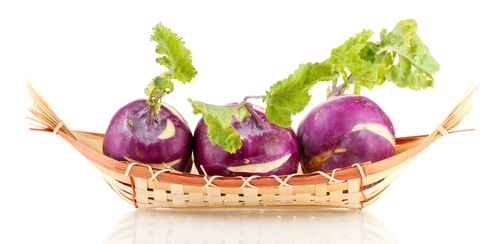
Apprenez à préparer les jus de légumes pour retrouver forme, vitalité et perdre du poids.
Les bienfaits santé du jus de navet.
« Qui mange du navet gagne une année » dit le dicton populaire.
- Le navet, comme tous les crucifères (famille à laquelle il appartient avec le rutabaga, le brocoli, le chou-fleur, le chou, le radis, le cresson…), contient des contient des glucosinolates, qui lorsqu’ils sont écrasés ou mastiqués se transforment en isothiocyanates qui vont freiner la croissance du cancer (1).
- Quand il est consommé régulièrement le navet permet d’éviter les cancers des ovaires, du poumon et le cancer des reins chez la femme (2).
- Les feuilles de navet sont riches en antioxydants (caroténoïdes) en particulier en lutéine et en zéaxanthine qui protège contre la dégénérescence maculaire et la cataracte (3).
Le navet est bien adapté pour faire les jus car il contient plus de 90% d’eau. Il est peu calorique, et riche en minéraux et oligo-éléments tels que le potassium (et donc à ce titre diurétique), le phosphore, le calcium, le sodium, le magnésium, le fer, le zinc, le cuivre, le manganèse et le sélénium.
Côté vitamines, il est bien pourvu en vitamines B3, B9 et C.
Fiche nutritionnelle pour 100 grammes.
Navet, pelé, cru.
| Nom Constituant | Teneur moyenne | Min | Max | Nb Echantillons | Code Source | Code Confiance |
| Energie, Règlement UE 1169/2011 (kJ/100g) | 87,9 | 99999 | A | |||
| Energie, Règlement UE 1169/2011 (kcal/100g) | 21,1 | 99999 | A | |||
| Energie, N x facteur Jones, avec fibres (kJ/100g) | 87,9 | 99999 | A | |||
| Energie, N x facteur Jones, avec fibres (kcal/100g) | 21,1 | 99999 | A | |||
| Eau (g/100g) | 93 | 88 | 94,60 | 3 | 15; 55; 105; 121; 157; 305; 445; 1664; 1673 | B |
| Protéines (g/100g) | 0,945 | 0,50 | 1,11 | 1 | 15; 55; 105; 121; 157; 293; 445; 1664; 1673 | B |
| Protéines brutes, N x 6.25 (g/100g) | 0,945 | 0,50 | 1,11 | 1 | 1193; 1664 | B |
| Glucides (g/100g) | 2,39 | 1 | 121; 157; 445; 1664 | D | ||
| Lipides (g/100g) | 0,26 | 0 | 0,30 | 1 | 15; 55; 105; 121; 157; 293; 445; 1664; 1673 | B |
| Sucres (g/100g) | 2,19 | 4 | 0 | 121; 445; 1673 | C | |
| Amidon (g/100g) | 0,196 | 0 | 0,69 | 1 | 121; 445 | C |
| Fibres (g/100g) | 2,7 | 1,80 | 3,49 | 1 | 157; 445; 1664; 1673 | C |
| Alcool (g/100g) | 0 | 0 | 445; 1673 | C | ||
| Polyols totaux (g/100g) | 0 | 99999 | B | |||
| Acides organiques (g/100g) | – | D | ||||
| AG saturés (g/100g) | 0,0055 | 0 | 0,01 | 0 | 445; 1673 | C |
| AG monoinsaturés (g/100g) | 0,003 | 0 | 6,0e-03 | 0 | 445; 1673 | C |
| AG polyinsaturés (g/100g) | 0,0265 | 0 | 0,05 | 0 | 445; 1673 | C |
| AG 4:0, butyrique (g/100g) | 0 | 0 | 1673 | D | ||
| AG 6:0, caproïque (g/100g) | 0 | 0 | 1673 | D | ||
| AG 8:0, caprylique (g/100g) | 0 | 0 | 1673 | D | ||
| AG 10:0, caprique (g/100g) | – | |||||
| AG 12:0, laurique (g/100g) | 0 | 0 | 1673 | D | ||
| AG 14:0, myristique (g/100g) | 0 | 0 | 1673 | D | ||
| AG 16:0, palmitique (g/100g) | 0,005 | 3 | 1673 | C | ||
| AG 18:0, stéarique (g/100g) | 0,0005 | 3 | 1673 | C | ||
| AG 18:1 9c (n-9), oléique (g/100g) | 0,003 | 99999 | D | |||
| AG 18:2 9c,12c (n-6), linoléique (g/100g) | 0,00442 | 99999 | D | |||
| AG 18:3 c9,c12,c15 (n-3), alpha-linolénique (g/100g) | 0,0221 | 99999 | D | |||
| AG 20:4 5c,8c,11c,14c (n-6), arachidonique (g/100g) | – | |||||
| AG 20:5 5c,8c,11c,14c,17c (n-3), EPA (g/100g) | 0 | 0 | 1673 | D | ||
| AG 22:6 4c,7c,10c,13c,16c,19c (n-3), DHA (g/100g) | 0 | 0 | 1673 | D | ||
| Sodium (mg/100g) | 33,8 | 4,50 | 78,50 | 2 | 15; 55; 105; 121; 157; 293; 305; 445; 1664; 1673 | B |
| Cholestérol (mg/100g) | < 0,1 | 0 | 1 | 445; 761; 1664; 1673 | B | |
| Magnésium (mg/100g) | 9,72 | 6,80 | 20 | 2 | 15; 55; 105; 121; 157; 293; 305; 1664; 1673 | B |
| Phosphore (mg/100g) | 26,4 | 11,70 | 50 | 2 | 15; 55; 105; 121; 157; 293; 305; 445; 1664; 1673 | B |
| Potassium (mg/100g) | 193 | 137 | 324 | 2 | 15; 55; 105; 121; 157; 293; 305; 445; 1664; 1673 | B |
| Calcium (mg/100g) | 38,7 | 16,80 | 65 | 2 | 15; 55; 105; 121; 157; 293; 305; 445; 1664; 1673 | B |
| Manganèse (mg/100g) | 0,0467 | 0,02 | 0,25 | 2 | 15; 105; 121; 157; 305; 1664; 1673 | B |
| Fer (mg/100g) | 0,258 | 0,19 | 1,50 | 2 | 15; 55; 105; 121; 157; 293; 305; 445; 1664; 1673 | B |
| Cuivre (mg/100g) | 0,0233 | 0,01 | 0,10 | 2 | 15; 105; 121; 157; 305; 1664; 1673 | B |
| Zinc (mg/100g) | 0,107 | 0,08 | 0,27 | 2 | 15; 105; 121; 157; 305; 445; 1664; 1673 | B |
| Sélénium (µg/100g) | 1,64 | 0 | 3,10 | 1 | 105; 157; 194; 305; 1664 | B |
| Iode (µg/100g) | 5,33 | 0,35 | 7,50 | 1 | 121; 157; 573; 1664 | C |
| Rétinol (µg/100g) | 0 | 1 | 105; 445; 1664; 1673 | B | ||
| Beta-Carotène (µg/100g) | 21,5 | 0 | 43 | 1 | 55; 445 | C |
| Vitamine D (µg/100g) | 0 | 1 | 55; 105; 445; 1664; 1673 | B | ||
| Vitamine E (mg/100g) | traces | 0 | 0,03 | 1 | 55; 105; 445; 1664 | B |
| Vitamine K (µg/100g) | – | |||||
| Vitamine C (mg/100g) | 18,5 | 10 | 36 | 1 | 15; 55; 105; 121; 157; 293; 445; 1664; 1673 | B |
| Vitamine B1 ou Thiamine (mg/100g) | 0,045 | 0,02 | 0,05 | 1 | 15; 55; 105; 121; 157; 293; 445; 1664; 1673 | B |
| Vitamine B2 ou Riboflavine (mg/100g) | 0,0305 | 0,01 | 0,07 | 1 | 15; 55; 105; 121; 157; 293; 445; 1664; 1673 | B |
| Vitamine B3 ou PP ou Niacine (mg/100g) | 0,535 | 0,40 | 1 | 1 | 15; 55; 105; 121; 157; 293; 445; 1664; 1673 | B |
| Vitamine B5 ou Acide pantothénique (mg/100g) | 0,2 | 0,19 | 0,23 | 1 | 15; 105; 121; 157; 1664; 1673 | B |
| Vitamine B6 (mg/100g) | 0,08 | 0,06 | 0,11 | 1 | 55; 105; 121; 157; 445; 1664; 1673 | B |
| Vitamine B9 ou Folates totaux (µg/100g) | 14 | 11 | 25,30 | 1 | 105; 121; 445; 1664; 1673 | B |
| Vitamine B12 (µg/100g) | 0 | 1 | 105; 1664; 1673 | B |
Source : Table de composition nutritionnelle Ciqual 2012.
Notes :
(1)(Zhang Y. Cancer-preventive isothiocyanates: measurement of human exposure and mechanism of action. Mutat Res 2004 November 2;555(1-2):173-90. ; Conaway CC, Yang YM, Chung FL. Isothiocyanates as cancer chemopreventive agents: their biological activities and metabolism in rodents and humans. Curr Drug Metab 2002 June;3(3):233-55. )
(2) Brennan P, Hsu CC, et al. Effect of cruciferous vegetables on lung cancer in patients stratified by genetic status: a mendelian randomisation approach. Lancet 2005 October 29;366(9496):1558-60. ; Pan SY, Ugnat AM, et al. A case-control study of diet and the risk of ovarian cancer. Cancer Epidemiol Biomarkers Prev 2004 September;13(9):1521-7. ).
(3) Ribaya-Mercado JD, Blumberg JB. Lutein and zeaxanthin and their potential roles in disease prevention. J Am Coll Nutr 2004 December;23(6 Suppl):567S-87S.
; Bone RA, Landrum JT, et al. Analysis of the macular pigment by HPLC: retinal distribution and age study. Invest Ophthalmol Vis Sci 1988 June;29(6):843-9.
; Moeller SM, Jacques PF, Blumberg JB. The potential role of dietary xanthophylls in cataract and age-related macular degeneration. J Am Coll Nutr 2000 October;19(5 Suppl):522S-7S.
(4) Stavric B. Quercetin in our diet : from potent mutagen to probable anticarcinogen. Clin Biochem 27, 1994 ; 45-48.
(5) Knekt P, Kumpulainen J, et al. Flavonoid intake and risk of chronic diseases. Am J Clin Nutr. 2002 Sep;76(3):560-8. Texte intégral : http://www.ajcn.org).
Résultats de votre recherche
- jus de navet bienfaits
- navet bienfaits

